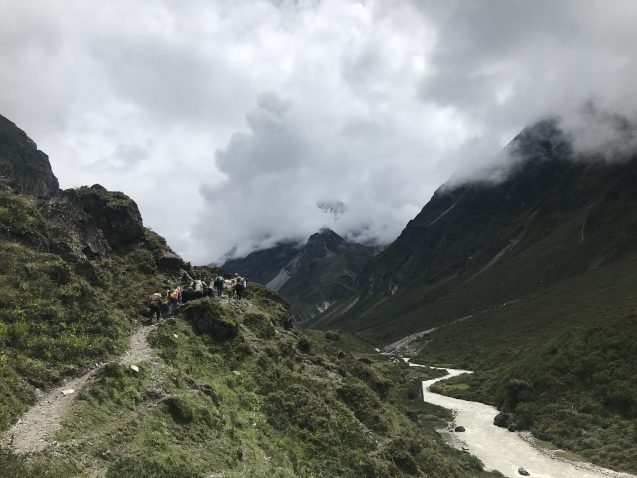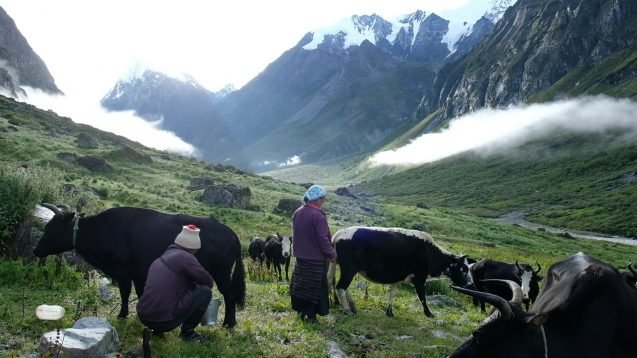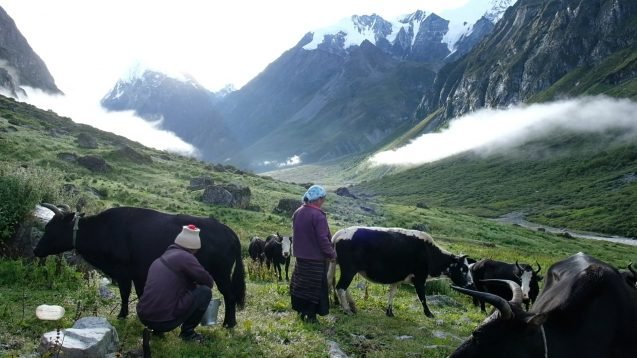Reviving pastoralist traditions might hold the key to building a more resilient community, economy, and environment
Nepal’s Langtang Valley is known for many things, from its remarkable Himalayan landscapes to its status as the origin of the country’s beloved yak cheese. Cheesemaking, which has a unique history in the region, relies on milk supplied by yak herders.
However, the traditional practice of herding is slowly disappearing. As Langtang, a popular travel destination deals with a volatile tourism industry reeling from the effects of COVID-19, reviving pastoralist traditions might hold the key to building a more resilient community, economy, and environment.

People in the Langtang Valley, located in north-central Nepal, have traditionally enjoyed a few different types of cheeses. One of these is chhurpi, a type of tangy Himalayan yak cheese that is famous for being rock-hard. But in the early 1950s, Swiss development workers backed by the United Nations Food and Agriculture Organization came to the valley and began a project to try something new: European-style cheesemaking in Langtang.
When they arrived in this rural region, livelihoods were focused on pastoralism and farming. Yak herding was common, and milk was used and consumed within families and exchanged on a small scale. After observing herders in the region, Swiss dairy experts thought that new forms of cheese production could be a good way to use the surplus milk produced by yaks in the summer, when monsoon rains sustain lush pastures and increase the animals’ milk production. Thus, they spearheaded a plan to build a facility in Langtang that would produce a new type of cheese using Swiss techniques. As Gyalbu Tamang, a cheesemaker in Langtang, describes in an essay for the Nepali Times, at first this effort was largely met with suspicion and reluctance from local yak herders, who did not want to give away their milk to foreigners imposing a largely externally-developed plan on the community. Swiss workers would sometimes “break into herders’ huts and confiscate the milk,” Tamang told the Times.

After the Swiss were able to persuade the village’s Lama, or religious leader, to support the initiative, locals also agreed, and the Europeans’ pet project took hold. Swiss workers and Langtang locals started producing a new yak cheese, much softer than chhurpi, in the newly built facility. The taste was unfamiliar to the people of Langtang, who slowly became accustomed to the cheese after the Swiss regularly gave away free samples. Despite its contentious origins, eventually this cheese became popular among locals and was sold to tourists visiting the valley, transported to Kathmandu, and distributed throughout Nepal. It is now enjoyed across the country and known for being made in the Langtang region.
The original cheese factory, which was built in a town called Kyangjin Gomba, is still in use today and operates mostly in the summer months. There are seasonal facilities located in nearby pastures as well as a handful of factories in other towns throughout the wider region. Many of the facilities still use the cheesemaking tools that were given to them by the Swiss decades ago. These old-fashioned tools are used in tandem with newer technologies for monitoring the cheesemaking process and ensuring hygiene.
The 2015 Nepal earthquake, which caused major destruction throughout the country, also had a debilitating impact on the Langtang Valley and its cheesemaking economy. The earthquake triggered landslides throughout the region, with unimaginable devastation in Langtang Village, one town in the valley. There, a massive avalanche took around 300 lives—a majority of the population—and wiped out the municipality’s infrastructure. Since then, recovery efforts throughout the valley have slowly but surely rebuilt homes, guesthouses, and even the cheese production center in Kyangjin Gomba, which was destroyed in the earthquake.
The earthquake was “a chance for us to breathe new life into cheese-making in Langtang,” Gyalbu Tamang told the Nepali Times. The Swiss Embassy donated to rebuilding efforts, and the cheesemakers were able to negotiate with the Nepal government’s Dairy Development Corporation, which oversees rural milk production, to set a higher selling price for yak milk. The extra income from the higher selling prices helped some farmers invest more in their yak herds following the tragedy. While this now-popular cheese is relatively new and introduced by a foreign entity, production and consumption on a larger scale caught on because it incorporates a very traditional part of Langtang culture: yak herding. Many yak herders in Langtang sell their surplus milk to the cheese factory, bringing in earnings far higher than they did decades ago. According to the Nepali Times, over 60 farmers supply milk to the cheese factory in Kyangjin Gomba. While it took some time to catch on when it was first established in the 1950s, factory cheese production is now a part of herders’ livelihoods and an option for many of them.

However, while cheese production throughout the region surrounding Langtang was on the rise in 2020, the practice of yak herding is declining and at risk in Langtang. This long-term trend may eventually force the local cheesemaking facilities to consider new options for sourcing milk.
Austin Lord, a PhD candidate in Anthropology at Cornell University who has studied and lived in Langtang, explained to GlacierHub the main reasons for the decline. The earthquake was one direct factor—the disaster killed 27 yak herders as well as 400 yaks, and struggles during the recovery process led several herders to retire.
Lord also explained that many yak herders are simply ageing out of the profession and there are few herders from younger generations that can replace them.
Yak herding is a laborious profession—herders spend nearly 10 months of the year travelling between pastures and camping with their yaks, enduring rain, snow, and cold temperatures. Young people from Langtang are instead attending school in cities like Kathmandu, spending less time at home, and opting to work in other industries, like tourism.
Tourism is the largest industry in Langtang and the basis of the majority of people’s livelihoods. In 1976, about two decades after the first cheesemaking facility was established in Kyangjin Gomba, the Nepal government established Langtang National Park. This was the country’s first protected area in the Himalayas, and the designation helped tourism skyrocket. By the 2000s, tourism was the largest industry in Langtang, far surpassing herding. Langtang is a popular spot for trekking through valleys, enjoying views of the mountains, seeing glaciers, and experiencing the Himalayan culture — including buying and tasting the famous Langtang cheese. Many people in Langtang own guesthouses and hotels or lead treks throughout the region.

Tourism, while dominant, can also be a volatile industry. Chhime Tamang, a trekking guide and guesthouse owner in Langtang, spoke to GlacierHub about the dearth of tourists due to the COVID-19 pandemic. The same thing happened following the 2015 earthquake. Tamang recalled the feeling of watching the news coverage of Langtang after the earthquake and lamenting not only the immense tragedy and loss of the situation, but also the impact it would have on tourism in the area. When tourism is low, locals are forced to dip into their savings, rely on local products instead of buying from Kathmandu, and sometimes grow food on their own. Right now, in the midst of the pandemic, Tamang said local residents are wondering “how to survive [and] waiting for the day [that tourism goes back to normal].”
While tourism is far more lucrative than yak herding, it depends partly on recognizable cultural symbols like yak herding to survive. The volatility of the tourism industry might provide an opportunity for yak herding to flourish again, according to Lord. Yak herding is not only a viable economic livelihood, but also a valuable part of community identity, and young people in Langtang have become increasingly interested in preserving their cultural heritage in the wake of the earthquake. This cultural heritage also includes language and religion—many in the area speak a regional dialect of Tibetan, along with Nepali, and practice Tibetan Buddhism.
Another concern for communities in Langtang is climate change, a major threat across the Himalayas. Anushilan Acharya, a research associate at the International Centre for Integrated Mountain Development (ICIMOD), explained to GlacierHub that glaciers throughout Nepal have been melting rapidly in recent decades. This can cause flooding and erosion in the short term, and water shortages in the long term. As glaciers continue to retreat, water shortages are expected to stunt grass growth and lead to less milk production from yaks. The effects of climate change are also leading to more unpredictable landslides, which threaten yaks and herders, and a decrease in arable land, including pastures for yaks to graze on.

According to Lord, the impacts of climate change on yak herding are especially concerning because of the ecological knowledge that herders possess, which emerges from their close relationship with the land. “These days, there are fewer people who live in and move through the landscape in a sustained way, as people used to,” Lord told GlacierHub. He reassured that there are, however, young people who are slowly “rediscovering the landscape and trying to learn about their environment in new ways.”
According to Acharya, as disappearing glaciers reshape renowned landscapes and more frequent landslides threaten trekking routes and villages, the tourism industry will suffer as well. This could destabilize the tourism-based economy even further, but the Langtang community can adapt by diversifying their sources of income. Despite the threats that yak herding faces, livelihood could still play an important role in the overall response to climate change.
A revival of yak herding, traditional agricultural practices, and sustainable cheese production could not only help avoid overreliance on tourism, but also revitalize the connections between culture and nature and equip locals with invaluable ecological knowledge.
Langtang has shown incredible resilience throughout recent history, from adopting cheesemaking to recovering in the wake of the earthquake. The full effects of numerous cultural and environmental changes remain to be seen but are not irresolvable. The adaptability of the people of Langtang and their close connection with their environment suggest that they may well find ways to respond to the newest challenge.
This article was first published in State of the Planet.

The High Asia Herald is a member of High Asia Media Group — a window to High Asia and Central Asia

